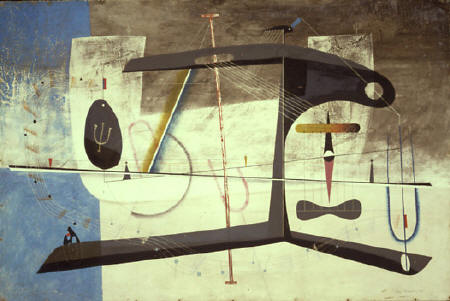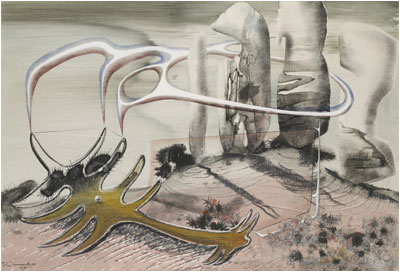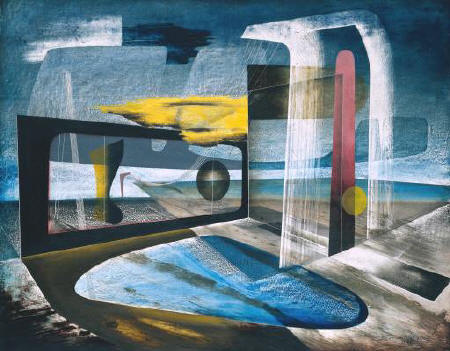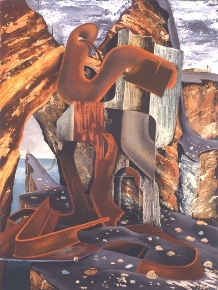|
John Tunnard
 John
Tunnard is one of the most accomplished, yet most forgotten, modernist
painters from Cornwall and he was one of a cluster of significant
artists inspired by Surrealism living outside St Ives. John
Tunnard is one of the most accomplished, yet most forgotten, modernist
painters from Cornwall and he was one of a cluster of significant
artists inspired by Surrealism living outside St Ives.
He was born on May 7, 1900, in
Bedfordshire, England. He graduated with a diploma in design from the
Royal College of Art in London in 1923 and for the next four years
worked as a textile designer in Manchester. In 1929 he gave up
commercial work to become a painter, supporting himself as a part-time
teacher of design at the Central School of Arts and Crafts in London.
Tunnard showed for the first time in 1931, at the Royal Academy of Arts
and continued to exhibit annually with the London Group until 1950,
becoming a member in 1934.
Tunnard’s first one-man show
was held at the Redfern Gallery in London in 1933. Most of the works
presented depicted the landscape of Cornwall, where the artist and his
wife had settled and established a hand block
 printed
silk business. Tunnard began at this time to revive his early interest
in natural science, collecting entomological specimens on the moors for
the British Museum of Natural History and observing the minutiae of
nature that provided a source of imagery for his art. Although he never
formally joined the Surrealist movement, Tunnard participated in several
of the group’s exhibitions in the 1930s, including Surrealism, held in
1939 at Gordon Fraser Gallery in Cambridge, which featured works by Max
Ernst, Klee, Magritte, Miró and others. In March 1939 Peggy Guggenheim
gave Tunnard a show at her gallery Guggenheim Jeune in London. printed
silk business. Tunnard began at this time to revive his early interest
in natural science, collecting entomological specimens on the moors for
the British Museum of Natural History and observing the minutiae of
nature that provided a source of imagery for his art. Although he never
formally joined the Surrealist movement, Tunnard participated in several
of the group’s exhibitions in the 1930s, including Surrealism, held in
1939 at Gordon Fraser Gallery in Cambridge, which featured works by Max
Ernst, Klee, Magritte, Miró and others. In March 1939 Peggy Guggenheim
gave Tunnard a show at her gallery Guggenheim Jeune in London.
Tunnard enlisted as an
auxiliary coast guard in 1940 and served for the duration of the war.
During this period he participated in group shows in London at the
Redfern Gallery, the Zwemmer Gallery and Alex Reid and Lefevre. The
British Council included his work in three survey exhibitions in
Australia and South America between1940 and 1949, and in 1944 the artist
was given a one-man show at the Nierendorf Gallery in New York. Tunnard
resumed teaching design in 1946 at Wellington College, Berkshire, and
two years later at Penzance School of Art, Cornwall. Also in 1946 he was
featured in 'Contemporary British Art', which travelled to the Toledo
Museum of Art, Ohio, the Albright Art Gallery, Buffalo, and the City Art
Museum, St. Louis. In 1949 his work was shown at the Salon des Réalités
Nouvelles in Paris. The artist designed a mural for the Festival of
Britain in 1951 and the following year he showed at Durlacher Brothers
in New York, where he would have a solo exhibition in 1960.
Tunnard was elected an
associate of the Royal Academy in 1967. In 1971 he was represented in
The British Contribution to Surrealism at Hamet Gallery in London. The
artist died that year on December 18. In 1977 a touring show travelled
from the Royal Academy, to Newlyn Art Gallery via Kettles Yard and a
number of other venues.
John Tunnard is an
individualist. For more than thirty years he has preferred to cut a path
of his own through the jungle of modern art. He began his career, as a
designer in the textile industry, and textiles is a craft that imposes
on the artist a high degree of stylisation, even of abstraction. He had
further disciplinary experience as a teacher of design at the Central
School of Arts and Crafts in London. Then in 1930, Tunnard left London
and moved to Cornwall, where together with his wife he set up a workshop
for hand-blocked printed silks. As soon as he was settled in this new
environment he began to paint.
 From
the beginning there was a mastery of oil, watercolour and gouache, but
gouache remained his favoured medium and of this medium he has become
one of the most skilled masters in England. From
the beginning there was a mastery of oil, watercolour and gouache, but
gouache remained his favoured medium and of this medium he has become
one of the most skilled masters in England.
Tunnard immediately found a formal language of his own, and one that is
not imitative or obviously related to the style of any of his immediate
predecessors... There can be no doubt that Tunnard was inspired by the
prevailing `will to abstraction', but I believe his inspiration comes
from a source somewhat unusual in modern art- nature.
It is well known that Tunnard is an expert naturalist- a lepidopterist,
a botanist and life-long observer of all forms of animal and plant life.
He had lives with nature as intimately as Gilbert White or Thoreau, and
his painting is always related to the forms of nature- not so much to
the outward forms, though these do sometimes do appear as identifiable
images, but rather to that inner morphology which is the secret of
nature. By this I do not mean anything so obvious as the structure of
organisms as revealed by science, but rather the formative principle
itself, a grasp of which enables that artist to create forms that are
analogous to those in nature...
Tunnard is an artist who has acquired by observation a profound
intuition of the workings of nature, and this enables him to imagine
forms that represent the morphology of nature in its ceaseless state of
flux. That intuition prevents the artist from becoming a mere
manipulator of a lifeless geometry. His forms are the inventions of his
imagination but that imagination is a complete world, in some sense a
prophetic world. He himself has said that after he has painted a picture
he will sometimes come across a form he has used without knowing that it
existed in nature...
Always in Tunnard's work, however dislocated they may be, the images
have an essentially organic origin, and even when the painting is
organised geometrically, with the fabric designer's precision, one is
still aware of a vital process, of an implicit animism.
 Animism
and vitalism are similar concepts, and they imply a virtue which is more
mechanical- dynamism. At times this characteristic in Tunnard's
compositions threatens to disrupt the organic harmony- titles like
Release, Flurry, Signal, Intersection, Flux, indicate geometrical lines
of force rather than organic development. But nature, at least in its
cosmic aspects, is also violent, and an art that did not reflect this
fact would be too tame. The ideal is to find a synthesis of growth and
form; but again, the forms that develop as living organisms. Animism
and vitalism are similar concepts, and they imply a virtue which is more
mechanical- dynamism. At times this characteristic in Tunnard's
compositions threatens to disrupt the organic harmony- titles like
Release, Flurry, Signal, Intersection, Flux, indicate geometrical lines
of force rather than organic development. But nature, at least in its
cosmic aspects, is also violent, and an art that did not reflect this
fact would be too tame. The ideal is to find a synthesis of growth and
form; but again, the forms that develop as living organisms.
The final effect is that of a dream-landscape, but `land' must imply
more than earth, and more than land and sea. The `scape' is the limits
of imaginative vision. Whatever the nature of the landscape, cosmic,
telluric or, as often, submarine, the world created by this artist is a
credible one. His work often reminds me of Sir Thomas Browne's Garden of
Cyprus, where he speaks of those `phantasmes of sleep, which often
continueth praecogitations, making Cables of Cobwebbes and Wildernesses
of handsome Groves'. Sir Thomas concludes: `All things began in order,
so shall they end, and so shall they begin again; according to the
ordainer of order and mystical Mathematics of the City of Heaven'. A
painting by John Tunnard begins in the order of nature; it traverses the
phantasms of the imagination; and then ends in the order of art, which
is an analogy of the mystical mathematics of the City of Heaven.
from Herbert Read, The World of John
Tunnard, The Saturday Book, volume 25, London 1965.
|


 printed
silk business. Tunnard began at this time to revive his early interest
in natural science, collecting entomological specimens on the moors for
the British Museum of Natural History and observing the minutiae of
nature that provided a source of imagery for his art. Although he never
formally joined the Surrealist movement, Tunnard participated in several
of the group’s exhibitions in the 1930s, including Surrealism, held in
1939 at Gordon Fraser Gallery in Cambridge, which featured works by Max
Ernst, Klee, Magritte, Miró and others. In March 1939 Peggy Guggenheim
gave Tunnard a show at her gallery Guggenheim Jeune in London.
printed
silk business. Tunnard began at this time to revive his early interest
in natural science, collecting entomological specimens on the moors for
the British Museum of Natural History and observing the minutiae of
nature that provided a source of imagery for his art. Although he never
formally joined the Surrealist movement, Tunnard participated in several
of the group’s exhibitions in the 1930s, including Surrealism, held in
1939 at Gordon Fraser Gallery in Cambridge, which featured works by Max
Ernst, Klee, Magritte, Miró and others. In March 1939 Peggy Guggenheim
gave Tunnard a show at her gallery Guggenheim Jeune in London.
 Animism
and vitalism are similar concepts, and they imply a virtue which is more
mechanical- dynamism. At times this characteristic in Tunnard's
compositions threatens to disrupt the organic harmony- titles like
Release, Flurry, Signal, Intersection, Flux, indicate geometrical lines
of force rather than organic development. But nature, at least in its
cosmic aspects, is also violent, and an art that did not reflect this
fact would be too tame. The ideal is to find a synthesis of growth and
form; but again, the forms that develop as living organisms.
Animism
and vitalism are similar concepts, and they imply a virtue which is more
mechanical- dynamism. At times this characteristic in Tunnard's
compositions threatens to disrupt the organic harmony- titles like
Release, Flurry, Signal, Intersection, Flux, indicate geometrical lines
of force rather than organic development. But nature, at least in its
cosmic aspects, is also violent, and an art that did not reflect this
fact would be too tame. The ideal is to find a synthesis of growth and
form; but again, the forms that develop as living organisms.